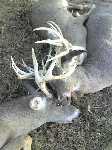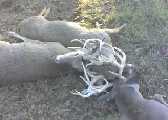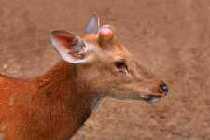 |
| |
Deer Management Solutions
About Deer Repellents and Deterant Solutions
Find up-to-date information and product reviews on deer repellents, deterants, deer resistant plants, deer ticks, government programs to help manage deer and more.
About Deer-Departed : Deer Departed News : Ultimate Deer Management Solutions |
| Ultimate Deer Management Solutions
Welcome to the all inclusive blog/newsletter about deer management. It's all here, products, research, resistant plant lists, reviews, fencing suggestions, home-made repellent recipes, it's all here.
March 15, 2008 18:19 - Death by Antlers
  I received these very sad pictures the other day. Three bucks had aparently got their antlers hung up and were unable to get them untangled. Another antler questions that has come up is why antlers seem to be different colors on some deer. Some antlers may be whiter and some browner. The color of the antlers can be influenced by the trees that the antlers have been rubbing on. It the bark is very dark on the trees, the antlers can look brown. Also the food the deer have been eating can influence antler color.
Thankfully, this is a rare photo.
Fawn I received these very sad pictures the other day. Three bucks had aparently got their antlers hung up and were unable to get them untangled. Another antler questions that has come up is why antlers seem to be different colors on some deer. Some antlers may be whiter and some browner. The color of the antlers can be influenced by the trees that the antlers have been rubbing on. It the bark is very dark on the trees, the antlers can look brown. Also the food the deer have been eating can influence antler color.
Thankfully, this is a rare photo.
Fawn
March 6, 2008 11:58 - Deer Ticks - Time to Watch for Lyme Disease
Lyme disease is more easily contracted in spring through summer when the tick population is its highest and when more people are outdoors in the ladnscape. In the past it was thought that ticks could be in the trees and then drop down on people. That isn't true. Ticks are in the grass and on shrubs then attach themselves when a host brushes by them. Ticks can not jump or fly, they only crawl. Deer ticks have several impressive methods for looking for hosts. These include monitoring carbon dioxide levels of victims, body heat, and other chemical indicators.
If you have deer in your landscape, follow the links to our deer resistant plants, homemade deer repellent recipes, deer repellent tips and general strategies for controling deer in your landscape.
Fawn
 Ultimate site for deer management
Ultimate site for deer management
February 14, 2008 13:27 - Deer Antlers Continued
 Deer antlers, who knew there was this much to them? How old is this guy above?
Deer antlers have four stages of growth. This four stage growth cycle is controlled by the buck's endocrine system and in response to seasonal changes like daylength. The first stage are the nascent antlers which emerge in the spring from the small stumps of bone on a male deer head called pedicles. These pre-antlers are covered with "velvet: and are soft and pliable. Velvet, as it is known since it looks like brown velevet, is actually a thin skin containing a vascular system that carriers minerals and proteins into the growing antlers. The first year, a fawn grows his pedicles. The second yer, he sprouts straight shafts, the first year the first branches appear. As he gets older the antlers will get longer and often he will get multiple branches.
It takes about three months for the antlers to reach full size. The velvet stays on the antlers for about four months from when they first began to grow. It comes off as the bone hardens.
In the fall, mating season begins and the velvet comes off. To help the velvet come off sooner, the buck often rubs his antlers against trees. This rubbing is also to sharpen the antlers.
Since female animals natural migrate to the healthiest males, it is believed that the female deer prefer the males with the biggest rack of antlers, since this is a sign of health.
The pedicles are the point from which the antlers annually break off in the spring. The antler shedding takes two to three weeks and shortly afterward the cycle starts again.
Next time you see a deer look closely and you will be able to roughly guess his age.
Fawn
Deer antlers, who knew there was this much to them? How old is this guy above?
Deer antlers have four stages of growth. This four stage growth cycle is controlled by the buck's endocrine system and in response to seasonal changes like daylength. The first stage are the nascent antlers which emerge in the spring from the small stumps of bone on a male deer head called pedicles. These pre-antlers are covered with "velvet: and are soft and pliable. Velvet, as it is known since it looks like brown velevet, is actually a thin skin containing a vascular system that carriers minerals and proteins into the growing antlers. The first year, a fawn grows his pedicles. The second yer, he sprouts straight shafts, the first year the first branches appear. As he gets older the antlers will get longer and often he will get multiple branches.
It takes about three months for the antlers to reach full size. The velvet stays on the antlers for about four months from when they first began to grow. It comes off as the bone hardens.
In the fall, mating season begins and the velvet comes off. To help the velvet come off sooner, the buck often rubs his antlers against trees. This rubbing is also to sharpen the antlers.
Since female animals natural migrate to the healthiest males, it is believed that the female deer prefer the males with the biggest rack of antlers, since this is a sign of health.
The pedicles are the point from which the antlers annually break off in the spring. The antler shedding takes two to three weeks and shortly afterward the cycle starts again.
Next time you see a deer look closely and you will be able to roughly guess his age.
Fawn
|
|
«
|

RSS Feed For This News
Deer Departed News |
Archives
|
|
|
|
|



